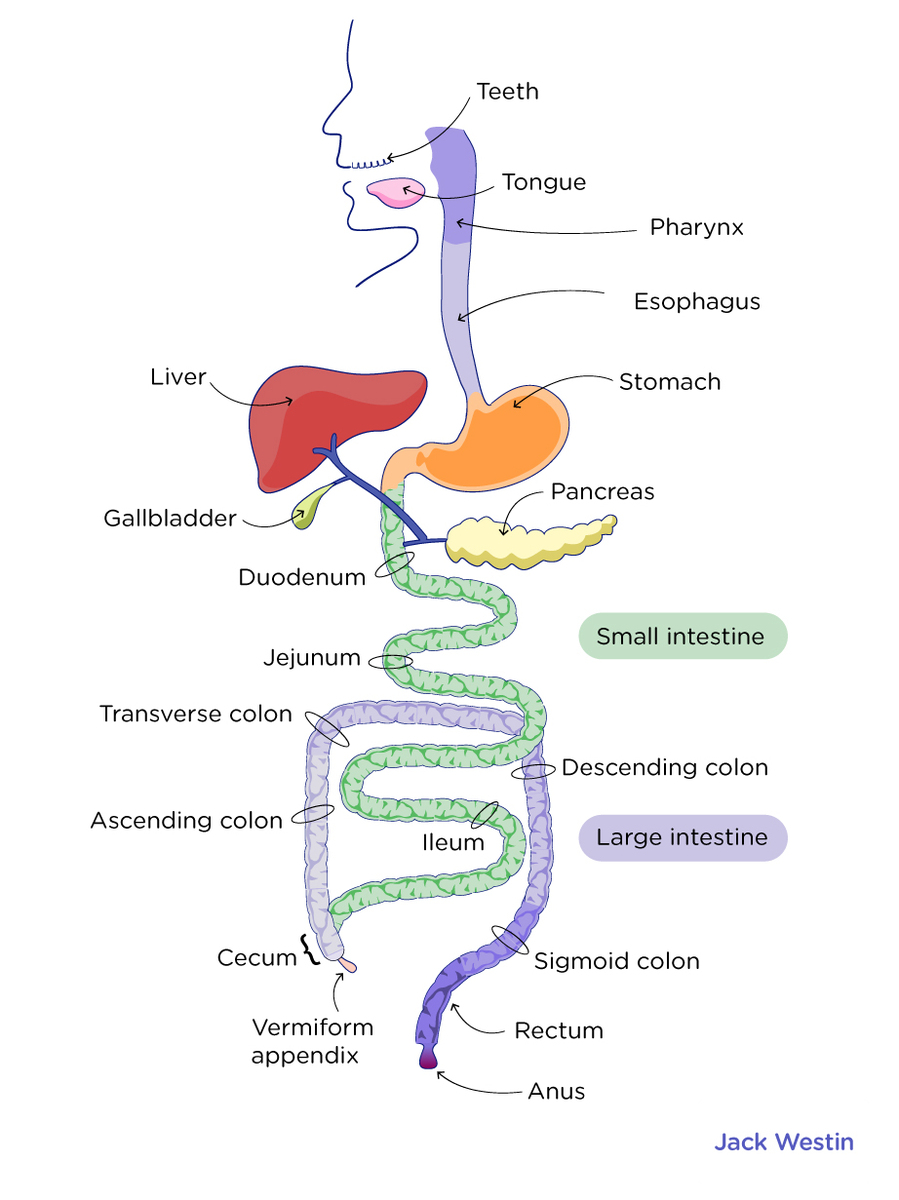The small intestine is a long tube-like organ with a highly-folded surface containing finger-like projections known as the villi. Villi increase the surface area of the walls. It is the organ where the digestion of protein, fats, and carbohydrates is completed, and the digested food is absorbed into the circulation.

The small intestine is divided into three sections: The duodenum is the first section of the small intestine and is the shortest part of the small intestine. It is where most chemical digestion using enzymes takes place. The jejunum is the middle section of the small intestine. It has a lining which is designed to absorb carbohydrates and proteins. The inner surface of the jejunum, its mucous membrane, is covered in projections called villi, which increase the surface area of tissue available to absorb nutrients from the gut contents. The ileum is the final section of the small intestine. The function of the ileum is mainly to absorb vitamin B12, bile salts, and any products of digestion that were not absorbed by the jejunum.

The wall of the small intestine has numerous finger-like protrusions known as villi. On these villi, numerous absorptive cells are present on which microvilli are present. The villi and microvilli increase the surface area of the small intestine that helps in the absorption of food molecules.

The small intestine is the site where the digestion of the food, including carbohydrates, fats, and proteins is completed, and the digested food is absorbed. Water is also absorbed here. Incomplete fat absorption blocks normal water absorption, leading to diarrhea.
Digested nutrients pass into the blood vessels in the wall of the intestine through a process of diffusion. The inner wall, or mucosa, of the small intestine, is lined with simple columnar epithelial tissue. Each villus has a network of capillaries and fine lymphatic vessels called lacteals close to its surface. Villi transport nutrients from the lumen of the intestine into capillaries.

The small intestine receives bile from the gall bladder and pancreatic juice from the pancreas. Bile helps in the digestion of fats, and the pancreatic juice contains digestive enzymes that help in the digestion of proteins, carbohydrates, and fats. Some enzymes such as proteases and amylase are secreted by the small intestine too. The pancreatic juice that is released in the duodenum part of the small intestine contains bicarbonates. These bicarbonates are alkaline and help to neutralize the acidic contents that move from the stomach to the duodenum.
All the digested food molecules are absorbed in the circulation. The fat molecules are absorbed in the lacteals (lymphatic vessels) and are then sent to the circulation.

Practice Questions
Khan Academy
The evolution of gecko toepads
MCAT Official Prep (AAMC)
Practice Exam 3 B/B Section Passage 10 Question 53
Practice Exam 3 B/B Section Passage 10 Question 55
Key Points
• The small intestine is the primary site of enzyme activity and nutrient absorption during digestion.
• Numerous villi and microvilli present in the wall of the small intestine increase the surface area for absorption.
• The small intestine receives bile from the gall bladder that helps in the digestion of fats and receives pancreatic juice (containing digestive enzymes) from the pancreas that helps in the digestion of fats, carbohydrates, and proteins. Amylase and protease secreted in the small intestine also help in the digestion.
• Water and digested food molecules are absorbed in the circulation, except the fat. Fat molecules are absorbed in the lacteals.
• The three anatomic parts of the small intestine are duodenum, jejunum, and ileum.
Key Terms
bile: secretion produced in the liver and stored in the gall bladder
lacteals: small lymphatic capillaries that absorb fat molecules from the small intestine
duodenum: the first part of the small intestine that starts at the lower end of the stomach and extending to the jejunum.
ileum: the last, and usually the longest, division of the small intestine; the part between the jejunum and large intestine.
small intestine: the upper part of the intestine, between the stomach and the large intestine, that is divided into the duodenum, the jejunum, and the ileum.
jejunum: the center of the three divisions of the small intestine that lies between the duodenum and the ileum
amylase: a common enzyme that breaks down carbohydrates
protease: an enzyme that breaks down proteins into amino acids
diffusion: a process where substances move from an area of high concentration to low concentration
villi: small, finger-like projections that extend into the lumen of the small intestine









